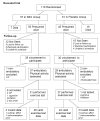Aerobic fitness and physical activity levels of children born prematurely following randomization to postnatal dexamethasone
- PMID: 20732688
- PMCID: PMC2993776
- DOI: 10.1016/j.jpeds.2010.07.007
Aerobic fitness and physical activity levels of children born prematurely following randomization to postnatal dexamethasone
Abstract
Objective: To investigate the effects of postnatal dexamethasone treatment on aerobic fitness and physical activity levels in school-aged children born with very low birth weight (VLBW).
Study design: This was a follow-up study of 65 VLBW infants who participated in a randomized controlled trial of dexamethasone (DEX) to reduce ventilator dependency. Aerobic fitness was determined from peak oxygen uptake (VO(2peak)) with a cycle ergometer. Habitual physical activity was assessed by questionnaire.
Results: A trend for a treatment with an interaction between treatment and of diagnosis of chronic lung disease (CLD) was found, with the children in the placebo group with CLD having the lowest VO(2peak) (P = .09). Reduced fitness was seen in 53% of the group treated with DEX and 48% of the group given placebo. No between-group differences in physical activity were seen. Parental reports suggested that nearly two-thirds of the children participated in < 1 hour per week of vigorous physical activity, which was explained in part by decreased large airway function (r = 0.30; P = .03).
Conclusions: We found no adverse effect of postnatal DEX on aerobic fitness or habitual physical activity at school age. However, the reduced fitness and physical activity levels emphasize the need for closer follow-up and early interventions promoting physical activity to reduce the risk of chronic disease in this at-risk population.
Copyright © 2011 Mosby, Inc. All rights reserved.
Conflict of interest statement
The authors declare no conflicts of interest.
Figures
Similar articles
-
Follow-up study of a randomized controlled trial of postnatal dexamethasone therapy in very low birth weight infants: effects on pulmonary outcomes at age 8 to 11 years.J Pediatr. 2007 Apr;150(4):345-50. doi: 10.1016/j.jpeds.2006.12.013. J Pediatr. 2007. PMID: 17382108 Free PMC article. Clinical Trial.
-
Outcomes at school age after postnatal dexamethasone therapy for lung disease of prematurity.N Engl J Med. 2004 Mar 25;350(13):1304-13. doi: 10.1056/NEJMoa032089. N Engl J Med. 2004. PMID: 15044641 Clinical Trial.
-
Aerobic and lung performance in premature children with and without chronic lung disease of prematurity.Clin J Sport Med. 2005 Sep;15(5):349-55. doi: 10.1097/01.jsm.0000180023.44889.dd. Clin J Sport Med. 2005. PMID: 16162994
-
Accelerometer-measured daily physical activity related to aerobic fitness in children and adolescents.J Sports Sci. 2011 Jun;29(9):887-95. doi: 10.1080/02640414.2011.578148. J Sports Sci. 2011. PMID: 21604226 Review.
-
Postnatal steroids and chronic lung disease in the newborn.Paediatr Respir Rev. 2004;5 Suppl A:S245-8. doi: 10.1016/s1526-0542(04)90046-2. Paediatr Respir Rev. 2004. PMID: 14980279 Review.
Cited by
-
Comparison of physical activity and body composition in a cohort of children born extremely preterm or with extremely low birth weight to matched term-born controls: a follow-up study.BMJ Paediatr Open. 2019 Jun 29;3(1):e000481. doi: 10.1136/bmjpo-2019-000481. eCollection 2019. BMJ Paediatr Open. 2019. PMID: 31338430 Free PMC article.
-
Effect of dexamethasone exposure on the neonatal unit on the school age lung function of children born very prematurely.PLoS One. 2018 Jul 9;13(7):e0200243. doi: 10.1371/journal.pone.0200243. eCollection 2018. PLoS One. 2018. PMID: 29985964 Free PMC article. Clinical Trial.
-
Impaired lung function and associated risk factors in children born prematurely: a systematic review and meta-analysis.Eur Respir Rev. 2024 Oct 9;33(174):240114. doi: 10.1183/16000617.0114-2024. Print 2024 Oct. Eur Respir Rev. 2024. PMID: 39384308 Free PMC article.
-
Systemic corticosteroid regimens for prevention of bronchopulmonary dysplasia in preterm infants.Cochrane Database Syst Rev. 2017 Jan 31;1(1):CD010941. doi: 10.1002/14651858.CD010941.pub2. Cochrane Database Syst Rev. 2017. Update in: Cochrane Database Syst Rev. 2023 Mar 13;3:CD010941. doi: 10.1002/14651858.CD010941.pub3. PMID: 28141913 Free PMC article. Updated.
References
-
- Hamilton BE, Martin JA, Ventura SJ. National Center for Health Statistics. National Vital Statistics Report; Hyattsville, MD: 2009. Mar 18, Births: Preliminary data for 2007. Report No.: Web release; vol 57 no 12.
-
- Lemons JA, Bauer CR, Oh W, Korones SB, Papile LA, Stoll BJ, et al. Very low birth weight outcomes of the National Institute of Child Health and Human Development Neonatal Research Network, January 1995 through December 1996. Pediatrics. 2001 Jan;107(1) art-e1. - PubMed
-
- Korhonen P, Laitinen J, Hyodynmaa E, Tammela O. Respiratory outcome in school-aged, very-low-birth-weight children in the surfactant era. Acta Paediatr. 2004 Mar;93(3):316–21. - PubMed
-
- Vrijlandt EJ, Gerritsen J, Boezen HM, Grevink RG, Duiverman EJ. Lung function and exercise capacity in young adults born prematurely. Am J Respir Crit Care Med. 2006 Apr 15;173(8):890–6. - PubMed



